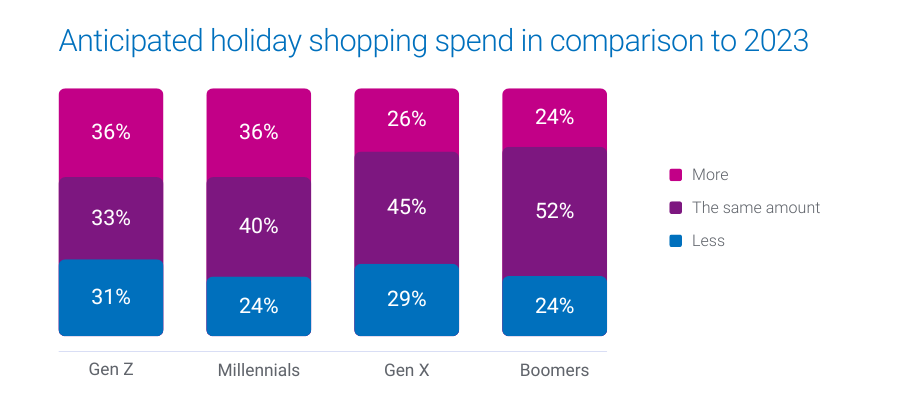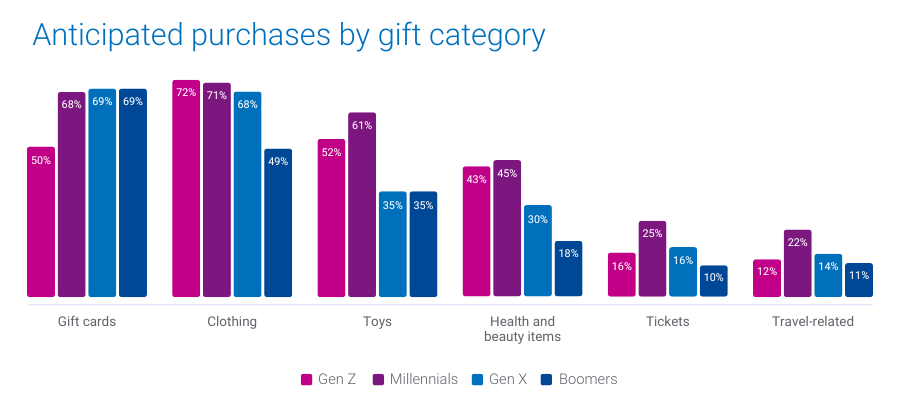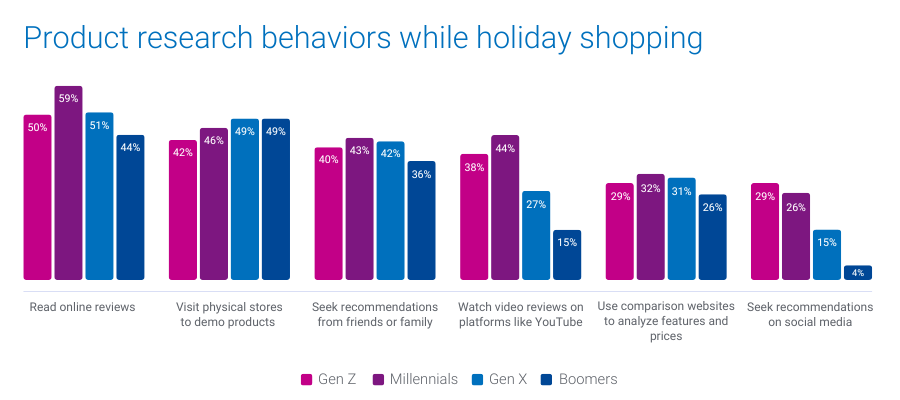
The holiday season is almost here, and knowing how each generation plans to shop can give your holiday advertising campaigns the edge you need. Our recent survey of 1,000 U.S. consumers reveals 2024 holiday shopping trends for each generation and key insights into their anticipated spending levels, preferred shopping categories, and how they look for gift ideas.
In this blog post, we’ll explore three 2024 holiday shopping trends across generations:
- Projected consumer spending
- Top categories on shoppers’ lists
- Preferred channels for researching gifts
1. Projected consumer spending
Over 1 in 3 Gen Z and Millennials are gearing up to increase their holiday budgets this year, while Gen X and Boomers are likelier to stick to last year’s budget.
- 36% of Millennials and Gen Z plan to spend more this holiday season
- 45% of Gen X and 52% of Boomers expect their spending to remain consistent with last year

What this means for marketers
These insights highlight the importance of tailoring your messaging. For Gen Z and Millennials, emphasize value and unique offerings that justify increased spending. For Gen X and Boomers, focus on trust and reliability, reinforcing their confidence in your brand.
How Experian can help you target these audiences
Experian’s custom and syndicated audience segments, including Holiday Shopper High Spenders and Holiday Shopper Moderate Spenders, enable you to connect with these diverse consumer groups. Our audiences are available on-the-shelf of leading ad platforms to help you reach people across social, TV, and mobile.
The election effect
U.S. holiday retail sales saw 4.1% YoY growth in 2016 and 8.3% YoY growth in 2020 following presidential elections. There’s a chance that holiday spending increases after the 2024 election, regardless of the outcome. Experian has 240+ politically relevant audiences that you can activate across major ad platforms ahead of the upcoming election.
2. Top categories on shoppers’ lists
Different generations have distinct preferences when it comes to what they plan to buy. Gift cards top the list for Gen X and Boomers, while Gen Z leans toward clothing. Millennials are looking to splurge on toys, electronics, and experiences.
- 69% of Boomers and Gen X plan to purchase gift cards
- 72% of Gen Z will buy clothing
- 45% of Millennials will buy health and beauty items
- 25% of Millennials will buy tickets and 22% of Millennials will buy experiences

What this means for marketers
Align your product offerings and promotions with each generation’s preferences to capture their attention. For example, highlighting versatile gift cards may resonate more with older generations, while showcasing trendy apparel and tech gadgets will appeal to younger consumers.
How Experian can help you target these shoppers
We offer audience segments like Holiday Shoppers: Apparel, Cosmetics & Beauty Spenders, and Toys Shoppers that you can activate to connect with consumers primed to purchase in these categories.
We recently released 19 new holiday shopping audiences we recommend targeting to drive engagement and conversions. Download our audience recommendations here.
3. Preferred channels for researching gift ideas
When it comes to finding the perfect gifts, Gen Z turns to social media, while Millennials prefer online reviews and video content. Boomers and Gen X are more inclined to visit physical stores for hands-on product evaluations.
- 29% of Gen Z and 26% of Millennials will look for gift ideas on social media
- 44% of Millennials will rely on video reviews and product demos on platforms like YouTube
- 49% of Gen X and Boomers plan to visit physical stores to evaluate products in person

What this means for marketers
Understanding where each generation looks for inspiration can guide your content and ad placement strategy. To engage Gen Z, focus on social media campaigns and influencer partnerships. For Millennials, consider investing in video content and reviews. For older generations, ensure your in-store experience is optimized to convert browsing into purchases.
How Experian can help you engage these shoppers
Our TrueTouchTM audiences can help you pair the perfect messaging styles with the right channels and calls to action. Our Social media channel and content engagement audiences can help you reach Gen Z who are likely to be active users on major social platforms and are Black Friday shoppers. For a full list of Experian’s syndicated audiences and activation destinations, download our syndicated audiences guide.
Download our report for five 2024 holiday shopping trends by generation
Understanding 2024 holiday shopping trends by generation can help you tailor your targeting, messaging, media planning, and creative based on the generation you’re targeting.
In addition to the insights covered here, download our 2024 Holiday spending trends and insights report to learn:
- When consumers plan to shop (hint: they’re already shopping)
- Where they plan to shop (online vs. in-store)
Download our full report to access all five of our predictions by generation, so you can address the diverse needs of this year’s holiday shoppers.
When you work with Experian for your holiday shopping campaigns, you’re getting:
- Accurate consumer insights: Better understand your customers’ behavioral and demographic attributes with our #1 ranked data covering the full U.S. population.
- Signal-agnostic identity solutions: Our deep understanding of people in the offline and digital worlds provides you with a persistent linkage of personally identifiable information (PII) data and digital IDs, ensuring you accurate cross-device targeting, addressability and measurement.
- Secure connectivity: Bring data and identity to life in a way that meets your needs by securely sharing data between partners, utilizing the integrations we have across the ecosystem, and using our marketing data in flexible ways.
Make the most of this holiday shopping season with Experian. Contact us today to get started.
Source
Online survey conducted in June, 2024 among n=1,000 U.S. adults 18+. Sample balanced to look like the general population on key demographics (age, gender, household income, ethnicity, and region).
Latest posts

As my colleague Jake Davis and I were planning this blog post, we had a lengthy conversation about what we were going to focus on. If you’ve experienced even one holiday season as a digital marketer, you know there’s a ton of crucial decisions to be made about your Q4 digital endeavors. Some of our clients have been planning since the end of the summer for “prime time,” and more than a few mentioned that they earn up to 40% of their annual revenue between October and December. Jake and I are both marketers – my perspective is from the strategy and planning angle, while Jake is The Man when it comes to data and analysis. Together, we make each other better by challenging each other’s ideas and perceptions. We think this blog post captures the best of both of our perspectives. Ultimately, there are a lot of variables at play all year long, but making smart decisions about creative, segmentation, deployment time, content, etc. carries a lot more weight as you close out Q4. I am interested in volume trends and thematic changes through the holiday season; because I believe marketers truly want to be proactive about crafting their holiday plans. In the real world, however, the calendar is a living document and a moving target – if a brand is not hitting its projections, course correction at the 11th hour can happen. Our goal is to ensure that type of recalibration is more the exception than the rule (and to give you some pointers even if you find the calendar is more of a guide than a concrete plan). Jake and our analytics team do some of their most innovative analysis annually, after the holiday season. That analysis of the 2015 holiday season, along with projected trends and industry developments, is what we are using to help frame this particular piece of thought leadership. With that being said, here are four charts and some explanations that can help you win by December 31st: 1. Peak Days Black Friday and Cyber Monday still have a hold on the public’s attention and wallet, even with promotions that began at the end of October. Factor in mobile shopping, and Cyber Monday in particular could be especially lucrative: mobile first consumers are ready, willing and even more able to make purchases from virtually anywhere, not just in front of their computers or tablets. But expect a decline in email marketing effectiveness from the year before…for all of the same reasons it will be so lucrative elsewhere. 2. Send size matters Batch and blast is probably here to stay, no matter how much we preach about the long-term benefits of smaller, targeted campaigns. Even the savviest marketers will resort to some large sends this holiday season, so when you do, it will serve you well to remember this maxim: volume is negatively correlated with email KPIs. Your send size might be the only reason you see a decline in your open rate – and that’s just math! 3. Animation: a key to unlocking engagement Animation has been around for a while now, but that doesn’t mean it’s any less effective. Last holiday season, mailings that included animation were clicked on 30% more than expected based on other trends. While that might because only the best mailings get this treatment, expect animation to get your customers moving. 4. Free shipping Free shipping was the most popular offer in 2015, although slightly less effective than 2014. As recent news about an increase in shipping rates reaches consumers, free shipping could prove to be even more compelling than past years. On the other hand, marketers that offer free shipping may see their bottom line affected (so prepare for Free Shipping with higher qualifiers, and remind your consumers about all the other great benefits they’ll receive by shopping with your brand). As with last year, our ultimate take-aways included the strong Jake and Liz approved suggestion to look at performance from your digital channels in a holistic sense. How have you been communicating with your customers the entire year? Is your website mobile optimized? Is your content personalized and relevant? Are you targeting the right audience? Are you using browse and abandon behavior to send triggered emails and make product recommendations? Most importantly, do you understand the context in which you’re deploying your email? It’s a competitive world out there, and most everyone has the same tricks up their sleeves. Be creative and daring when thinking of what minor innovations could prove major to your bottom line. While the charts above describe holiday 2015 (and rest assured, they will likely describe holiday 2016), it’s the tiny variations – the curious interpretations – that will drive your program forward. And when you’re struggling to come up with that variation? We’re here to help. Read more analytics posts here.

NEW YORK, Nov. 29, 2016 /PRNewswire/ — For the second consecutive year, Tapad, part of Experian, has been listed among Deloitte's Technology Fast 500™, a ranking of the 500 fastest-growing technology, media, telecommunications, life sciences and energy tech companies in North America. Tapad, number 147 on the 2016 Deloitte list, is the leading provider of unified, cross-device marketing technology solutions. "It is an honor to once again be recognized by Deloitte for our growth and momentum, particularly given the stature of the other technology companies on the list," said Are Traasdahl, founder and CEO of Tapad. "Our product innovation, particularly in TV analytics and measurement, is a major contributor to our progress. I'm extremely proud of our hard-working, talented team for continually executing at such a high level." "Today, when every organization can be a tech company, the most effective businesses not only foster the courage to explore change, but also encourage creativity in using and applying existing assets in new ways, as resourcefully as possible," said Sandra Shirai, principal, Deloitte Consulting LLP and U.S. technology, media and telecommunications industry leader. "This ingenious approach to innovation calls for the encouragement of curiosity and collaboration both within and outside the office walls." "This year's Fast 500 winners showcase that when organizations are open to diverse perspectives and insights, they are able to create an environment for their employees and customers to see the possibilities and ingenious solutions that might lie ahead," added Jim Atwell, national managing partner of the emerging growth company practice, Deloitte & Touche LLP. "Entrepreneurial environments foster change and innovation within businesses, and we look forward to watching these companies continue to drive change across all sectors." Contact us today

Distribution via LiveRamp enables seamless cross-device customer experiences through more platforms NEW YORK, Nov. 15, 2016 /PRNewswire/ — Tapad, now part of Experian and the leading provider of unified cross-device marketing technology solutions, today announced an expanded partnership with LiveRamp™, an Acxiom® company and leading provider of omnichannel identity resolution, to make the proprietary Tapad Device Graph™ accessible beyond Tapad-hosted direct integrations. Through LiveRamp, Tapad's Device Graph Access now extends to more than 400 ad tech and mar tech platforms. Tapad's Device Graph™ enables marketers to understand, monetize and measure consumer engagement across all digital channels, and Tapad's unified consumer view is recognized as one of the most accurate, scalable cross-device solutions in the market today. Through the expanded partnership with LiveRamp, the Tapad Device Graph can be distributed to the hundreds of platforms used to reach consumers on digital channels and measure campaign performance – even as devices are added daily to Tapad's extensive graph. "Increasingly, marketers want access to cross-device targeting and measurement capabilities within their preferred platforms," said Anneka Gupta, chief product officer of LiveRamp. "Our expanded partnership makes it easy for marketers to access Tapad's graph through the rapidly growing set of integrations available in our partner ecosystem." This is the latest of several initiatives between the two technology platforms designed to make the integration of cross-screen platforms seamless, privacy-safe and easy to use for dynamic and engaging marketing efforts. "During the past year, Tapad has expanded its global presence and rapidly grown its data business – Tapad Coral – doubling the number of companies integrating our device graph into their platforms and growing our annualized run rate by 210%," said Pierre Martensson, GM of Tapad Coral and APAC. "Our expanded partnership with LiveRamp positions us to meet the increased demand for Tapad Device Graph Access and enable new platforms to apply our graph with unprecedented speed." Connect with us today to get started